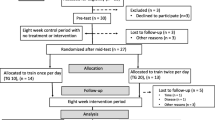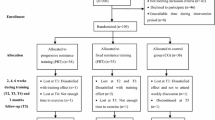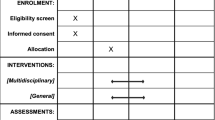Abstract
Effectiveness of exercise therapy in video display unit (VDU) workers with work-related chronic neck pain (W-RCNP) is unclear. The aim of the study was to assess the efficacy of group-based neck-shoulder resistance exercises on symptoms and muscular function in VDU workers with W-RCNP. Thirty-five employees with CNP were randomly assigned to neck-shoulder resistance exercise (NSRE) group or to conventional stretching and postural exercise (SPE) group. Participants trained 45 min, twice a week for 7 weeks. Primary outcomes were pain intensity (0–10 numeric rating scale, NRS) and pain-related disability (Vernon Neck Disability Index, NDI). Secondary outcomes were cervical active range of motion (AROM), endurance of neck flexors, strength of shoulder abductors, and health-related quality of life (SF-36). Post-treatment, pain and disability decreased 2.5 and 5 points in NSRE (p = 0.001) and 5 and 8 points in SPE (p = 0.002), with no significant differences between groups. AROM improved significantly in both groups; between-group differences were not significant. Neck flexors endurance and shoulder abductors strength improved by 59.6 and 34.2% (p = 0.001) in the NSRE group and by 27.6% (p = 0.009) and 2.3% (p = 0.002) in the SPE group; between-group differences were significant (p = 0.016 and p < 0.001, respectively). SF-36 score remained unchanged. NSRE and SPE are feasible and equally effective in reducing pain and pain-related disability as group exercises in W-RCNP. NSRE may provide some advantage in improving strength and endurance in neck muscles. Further, larger studies should confirm these findings and assess whether a better muscle function confers long-term clinical advantages.

Similar content being viewed by others
References
Janwantanakul P, Pensri P, Jiamjarasrangsri V, Sinsongsook T (2008) Prevalence of self-reported musculoskeletal symptoms among office workers. Occup Med 58(6):436–438
Côté P, van der Velde G, Cassidy JD et al (2009) The burden and determinants of neck pain in workers. results of the bone and joint decade 2000–2010 task force on neck pain and its associated disorders. J Manip Physiol Ther 32:70–86
Daffner SD, Hilibrand AS, Hanscom BS, Brislin BT, Vaccaro AR, Albert TJ (2003) Impact of neck and arm pain on overall health status. Spine (Phila Pa 1986) 28(17):2030–2035
Karlsson ML, Busch H, Aboagye E, Jensen I (2015) Validation of a measure of health-related production loss: construct validity and responsiveness-a cohort study. BMC Public Health 15(1):1
Cagnie B, Danneels L, van Tiggelen D et al (2007) Individual and work related risk factors for neck pain among office workers: a cross sectional study. Eur Spine J 16(5):679–686
Wærsted M, Hanvold TN, Veiersted KB (2010) Computer work and musculoskeletal disorders of the neck and upper extremity: a systematic review. BMC Musculoskelet Disord. doi:10.1186/1471-2474-11-79
Johnston V, Jull G, Souvlis T, Jimmieson NL (2008) Neck movement and muscle activity characteristics in female office workers with neck pain. Spine (Phila Pa 1986) 33:555–563
O'Leary S, Falla D, Elliott JM, Jull G (2009) Muscle dysfunction in cervical spine pain: implications for assessment and management. J Orthop Sports Phys Ther 39(5):324–333
Verhagen AP, Bierma-Zeinstra SMA, Burdorf A, Stynes SM, de Vet HCW, Koes BW. (2013) Conservative interventions for treating work-related complaints of the arm, neck or shoulder in adults. Cochrane Database Syst Rev (Issue 12) Art. No.: CD008742. doi: 10.1002/14651858.CD008742.pub2
Van Eerd D, Munhall C, Irvin E et al (2016) Effectiveness of workplace interventions in the prevention of upper extremity musculoskeletal disorders and symptoms: an update of the evidence. Occup Environ Med 73:62–70
Waling K, Sundelin G, Ahlgren C, Jarvholm B (2000) Perceived pain before and after three exercise programs: a controlled clinical trial of women with work-related trapezius myalgia. Pain (Phila Pa 1986) 85:201–207
Kietrys DM, Galperb JS, Vernoc V (2007) Effects of at-work exercises on computer operators. Work 28:67–75
Blangsted AK, Søgaard K, Hansen EA, Hannerz H, Sjøgaard G (2008) One-year randomized controlled trial with different physical-activity programs to reduce musculoskeletal symptoms in the neck and shoulders among office workers. Scand J Work Environ Health 34(1):55–65
Sjögren T, Nissinen KJ, Järvenpää SK, Ojanen MT, Vanharanta H, Mälkiä EA (2005) Effects of a workplace physical exercise intervention on the intensity of headache and neck and shoulder symptoms and upper extremity muscular strength of office workers: a cluster randomized controlled cross-over trial. Pain (Phila Pa 1986) 116(1):119–128
Andersen CH, Andersen LL, Gram B, Pedersen MT, Mortensen OS, Zebis MK, Sjøgaard G (2012) Influence of frequency and duration of strength training for effective management of neck and shoulder pain: a randomised controlled trial. Br J Sports Med 46(14):1004–1010
Andersen CH, Andersen LL, Zebis MK, Sjøgaard G (2014) Effect of scapular function training on chronic pain in the neck/shoulder region: a randomized controlled trial. Journal of Occupation Rehabilitation 24(2):316–324
Coury HJ, Moreira RF, Dias NB (2009) Evaluation of the effectiveness of workplace exercise in controlling neck, shoulder and low back pain: a systematic review. Brazilian Journal of Physical Therapy 13(6):461–479
Zebis MK, Andersen LL, Pedersen MT et al (2011) Implementation of neck/shoulder exercises for pain relief among industrial workers: a randomized controlled trial. BMC Musculoskelet Disord 12(1):1. doi:10.1186/1471-2474-12-205
Ylinen J, Takala EP, Nykänen M et al (2003) Active neck muscle training in the treatment of chronic neck pain in women. A randomized controlled trial. JAMA 289(19):2509–2516
Andersen L, Kiar M, Sogaard K, Hansen L, Kryger AI, Sjogaard G (2008) Effect of two contrasting types of physical exercise on chronic neck muscle pain. Arthritis Rheum 59(1):84–91
Ratamess NA, Brent AA, Evetoch TK, Housh TJ, Ben Kibler W, Kraemer WJ, Triplett NT (2009) American College of Sports Medicine position stand. Progression models in resistance training for healthy adults. Med Sci Sports Exerc 41(3):687–708. doi:10.1249/MSS.0b013e3181915670
IJmker S, Huysmans M, Blatter BM, van der Beek AJ, van Mechelen W, Bongers PM (2007) Should office workers spend fewer hours at their computer? A systematic review of the literature. Occup Environ Med 64:211–222. doi:10.1136/oem.2006.026468
Kovacs FM, Abraira V, Royuela A, Corcoll J, Alegre L, Tomás M, del Real MTG (2008) Minimum detectable and minimal clinically important changes for pain in patients with nonspecific neck pain. BMC Musculoskelet Disord 9(1):1
Kuorinka I, Jonsson B, Kilbom A, Vinterberg H, Biering-Sørensen F, Andersson G, Jørgensen K (1987) Standardised Nordic questionnaires for the analysis of musculoskeletal symptoms. Appl Ergon 18(3):233–237
Andrade-Ortega JA, Delgado Martínez AD, Almécija RR (2010) Validation of the Spanish version of the Neck Disability Index. Spine (Phila Pa 1986) 35(4):E114–E118
de Koning CH, van den Heuvel SP, Staal JB, Smits-Engelsman BC, Hendriks EJ (2008) Clinimetric evaluation of active range of motion measures in patients with non-specific neck pain: a systematic review. Eur Spine J 17(7):905–921
O’Leary S, Falla D, Jull J, Vicenzino B (2007) Muscle specificity in tests of cervical flexor muscle performance. J Electromyogr Kinesiol 17:35–40
Brzycki M (1993) Strength testing-predicting a one-rep max from reps-to-fatigue. Journal of Physical Education, Recreation & Dance 64(1):88–90
Vilagut G, Ferrer M, Rajmil L et al (2005) El Cuestionario de Salud SF-36 español: una década de experiencia y nuevos desarrollos. Gac Sanit 19(2):135–150
Jordan JL, Holden MA, Mason EE, Foster NE (2010) Interventions to improve adherence to exercise for chronic musculoskeletal pain in adults. Cochrane Database Syst Rev 20(1):CD005956
Jull GA, Falla D, Vincenzino B, Hodges PW (2009) The effect of therapeutic exercises on activation of the deep cervical flexor muscles in people with chronic neck pain. Man Ther 14:696–701
Ludewig PM, Hoff MS, Osowski EE, Meschke SA, Rundquist PJ (2004) Relative balance of serratus anterior and upper trapezius muscle activity during push-up exercises. Am J Sports Med 32(2):484–493
Chen J, Solinger AB, Poncet JF, Lantz CA (1999) Meta-analysis of normative cervical motion. Spine (Phila Pa 1986) 24(15):1571
Harris KD, Heer DM, Roy TC, Santos D, Whitman JM, Wainner RS (2005) Reliability of a measurement of neck flexor muscle endurance. Phys Ther 85(12):1349–1355
Alonso J, Regidor E, Barrio G, Prieto L, Rodríguez C, de la Fuente L (1998) Valores poblacionales de referencia de la versión española del Cuestionario de Salud SF-36. Med Clin 111(11):410–416
Macdermid JC, Walton DM, Avery S, Blanchard A, Etruw E, Mcalpine C, Goldsmith CH (2009) Measurement properties of the neck disability index: a systematic review. J Orthop Sports Phys Ther 39(5):400–417
Fletcher JP, Bandy WD (2008) Intrarater reliability of CROM measurement of cervical spine active range of motion in persons with and without neck pain. J Orthop Sports Phys Ther 38(10):640–645
Andersen LL, Andersen CH, Mortensen OS, Poulsen OM, Bjørnlund IBT, Zebis MK (2010) Muscle activation and perceived loading during rehabilitation exercises: comparison of dumbbells and elastic resistance. Phys Ther 90(4):538–549
Beer A, Treleaven J, Jull G (2012) Can a functional postural exercise improve performance in the cranio-cervical flexion test?—a preliminary study. Man Ther 17(3):219–224
Ylinen J, Salo P, Nykänen M, Kautiainen H, Häkkinen A (2004) Decreased isometric neck strength in women with chronic neck pain and the repeatability of neck strength measurements. Arch Phys Med Rehabil 85(8):1303–1308
VII Encuesta Nacional de Condiciones de Trabajo (2011). Instituto Nacional de Seguridad e Higiene en el Trabajo. http://encuestasnacionales.oect.es/. Accessed 13 Sept 2013
Larsson B, Søgaard K, Rosendal L (2007) Work related neck–shoulder pain: a review on magnitude, risk factors, biochemical characteristics, clinical picture and preventive interventions. Best Pract Res Clin Rheumatol 21(3):447–463
Acknowledgements
The authors thank Dr. Alfredo Mira for the assistance in the recruitment of participants and Dr. Manuel Bejarano-Bache and Dr. Eleonora Pagni for the assistance in the assessment of participants.
Author information
Authors and Affiliations
Corresponding author
Ethics declarations
The Research Ethics Committee of the Pablo de Olavide University approved the study (reference: 1/2012) that was performed in accordance with the ethical standards of the Declaration of Helsinki and its later amendments. All participants provided written informed consent prior to commencing the study.
Disclosures
None.
Rights and permissions
About this article
Cite this article
Caputo, G.M., Di Bari, M. & Naranjo Orellana, J. Group-based exercise at workplace: short-term effects of neck and shoulder resistance training in video display unit workers with work-related chronic neck pain—a pilot randomized trial. Clin Rheumatol 36, 2325–2333 (2017). https://doi.org/10.1007/s10067-017-3629-2
Received:
Revised:
Accepted:
Published:
Issue Date:
DOI: https://doi.org/10.1007/s10067-017-3629-2




